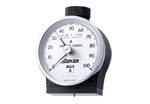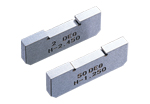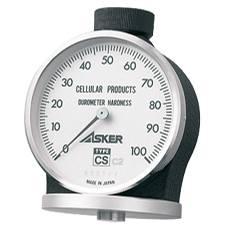|
|
 |
| Indentor |
 |
Height: 2.54mm Shape: Cylindrical |
|
 |
| Pressure foot |
 |
A 50mm diameter pressure foot in contact with a specimen, is wide enough to offer stable measurement. |
|
 |
| Hardness Tester Selection Chart |
 |
 |
Our product line consists of various types of durometers applicable to specific materials
as indicated in the chart above.
Type A Durometer (ASKER A type), conforming to JIS K 6235 is the most popular type of durometer for measuring rubber hardness.
However, verification is recommended because a significant difference is estimated to be the largest when a durometer indicates measurement values from 10 to 90 points.
For hard specimens for which Type A Durometer readings indicate more than 90 points, measurements should be undertaken using the Type D Durometer (ASKER D type). However, for soft specimens with measurements of less than 20 points, the ASKER C type or Type E Durometer (ASKER E type) should be used. The most important consideration in using durometers is to select the correct type for purposes of measurement according to the specimen.
|
|
 |
Specification |
|
 |
 |
| Indication range |
 |
0 point - 100 point (262 degree dial scale) |
|
 |
| Minimum indication |
 |
1 point (Accuracy : ±1 point) |
|
 |
| Indentor Design (mm) |
 |
Height: 2.54 10 Dia. Cylindrical |
|
 |
| Spring Forces [mN(g)] |
 |
|
|
 |
| Central hole of diameter of Pressure foot |
 |
Φ10.5 |
|
 |
Pressure foot
Dimension (mm) |
 |
Φ50(Round shape) |
|
 |
| Outer Dimension (mm) |
 |
Approx. Width 50×Depth 50×Height 76 |
|
 |
| Weight (g) |
 |
250 |
|
 |
| Application |
 |
Polystyrene foam |
|
 |
|
 |
Option |
|
 |
 |
|
 |
Two-pointer type (max-hand and active hand) of Rubber Hardness Tester
The stationary set hand (max-hand) makes the maximum value easier to read and allows the creep characteristics of a specimen.
Accurate measurement is made possible for specimens* for which stress relaxation occurs over time or for specimens for which it is difficult to take readings from the front.
*Materials for which the reading decreases immediately after the indentor has been pressed against the surface. |
|
 |
 |
|
 |
Indentor Extension Tester
| · |
The gauge to check the indentor height on a durometer and the reading indicator mechanism. |
| · |
Inspection is conducted at 2, 50, and 100 points respectively. |
|
|
|







